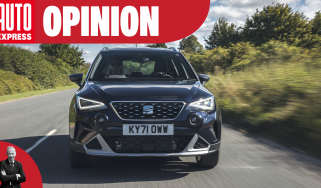Fisker Karma
We give the official verdict on Fisker's luxury performance hybrid - can the Karma take on the likes of the Porsche's green Panamera?
Just as Tesla proved electric cars can be sporty, Fisker is attempting to take plug-in hybrids to a new level. An electric-only range of 50 miles, plus impressive pace when the petrol engine kicks in, have the competition licked on paper. The Karma is spacious, stylish and sporty to drive, too – but it’s not perfect. The noisy engine is an unacceptable compromise on a luxury car such as this, and buyers will need some convincing to spend so much on an unknown brand.
A new challenger has entered the ring! It’s been a long time coming, but the Fisker Karma plug-in hybrid is finally here, promising a 50-mile electric range, blistering pace and luxurious cabin. We’re first behind the wheel of the innovative upstart.
It’s a tough task for an entirely new firm to take on the might of the Porsche Panamera and Aston Martin Rapide, yet the Karma’s credentials look good. A 255bhp GM-sourced 2.0-litre petrol turbo drives a generator, which keeps the lithium-ion batteries topped up.
These in turn work a pair of 201bhp electric motors attached to the rear axle, so petrol power is never used to directly drive the wheels. In Stealth mode, you can travel 50 miles on battery power alone. Switch to the Sport setting, and the engine cuts in – keeping the batteries energised and unleashing a boost in power. To ensure the car is primed for its zero-emissions mode, it can be fully charged in less than six hours from a conventional plug.
When we hit the track in our model, the most noticeable thing was the impact of engaging Sport mode. Instantly, the 0-60mph time falls from 7.9 seconds in Stealth to 5.9 seconds, and top speed rises 30mph to 125mph. Even with the four-cylinder engine spinning away under the bonnet, Fisker claims the Karma will return 37.7mpg – impressive for a large car with a serious turn of speed.
Numb steering doesn’t deliver Porsche levels of feedback, but the firm has made up for this in other areas. The wheelbase is 250mm longer than any rival’s and there’s a wide track. Add a low centre of gravity – thanks to the 275kg underfloor battery pack – and the car feels planted and resists body roll well in bends.
The Karma weighs around 2,100kg – that’s 200kg heavier than the 4WD Panamera – and has a big torque advantage. It produces a huge 1,330Nm from zero rpm, and with only one ratio – and therefore no gearchanges – acceleration is relentless.
Used - available now

2022 Peugeot
E-2008
21,779 milesAutomaticElectric
Cash £14,600
2020 Volkswagen
Tiguan
39,284 milesAutomaticPetrol2.0L
Cash £24,400
2020 Audi
A3 Sportback
38,198 milesManualPetrol1.5L
Cash £15,300
2023 Land Rover
Range Rover Evoque
25,475 milesManualDiesel2.0L
Cash £21,100The styling won’t be to all tastes, especially the moustache-like grille, but there’s no denying the elegant silhouette. Designer Henry Fisker also has Aston’s DB9 and V8 Vantage in his portfolio, so there’s definite pedigree here.
To really compete with the world’s biggest premium brands, though, the cabin needs to live up to the near-£100,000 price tag. The leather-clad layout certainly delivers on creature comforts, and there’s space for four adults, too. The onboard computer uses a 10.2-inch screen to control the car’s myriad functions. There’s even a sun panel gauge for the solar roof, which displays how effectively the panels are working and how many ‘free’ miles their charge translates to.
Our only real criticism of this pre-production car is the noise of the engine in Sport mode. At high speeds, the sound of the road and wind drown this out, but at low to medium speeds it’s intrusive. Engineers assured us an all-new muffler is on order to rectify this before customer deliveries start at the end of May.
For interested UK buyers, there is good and bad news: the Karma will be on sale in this country, but no right-hand-drive models will be built. A predicted £81,500 tag, rising to £94,600 for a top-spec model, appears expensive, but it compares favourably with rivals such as the £86,146 Panamera Hybrid. And when you consider the Karma is effectively free to run for sub-50-mile trips, it starts to look like a good deal.
Rival: Porsche Panamera S Hybrid
Electric power meets V6 muscle to create Porsche’s most efficient car ever. Luxury saloon can travel only 1.25 miles on electric power, though, before the petrol engine is called on – meaning 30mpg is as good as you can hope for.







